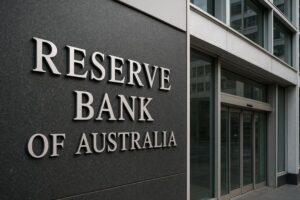RBA November Call: Could a Surprise Rate Cut Spark the Next ASX Rally?
![]() Ujjwal Maheshwari, October 31, 2025
Ujjwal Maheshwari, October 31, 2025
The Reserve Bank of Australia meets next week, and while most expect rates to stay put, the conversation is shifting. The economy is showing cracks, retail spending is soft, housing is cooling, and unemployment is rising. That raises an interesting question: what if the RBA surprises with a November rate cut? It sounds unlikely, but even if the central bank holds steady, lower rates are coming eventually. And when they do, certain ASX sectors will move fast. Understanding which ones benefit most could help position your portfolio ahead of the curve.
What are the Best Bank stocks to invest in right now?
Check our buy/sell tips
What’s Happening with the RBA?
The RBA has cut interest rates three times this year, bringing the cash rate down to 3.6%. But after the August cut, they hit the brakes. Inflation remained within the RBA’s 2–3% target range in September, with the most recent quarterly CPI reading at 2.1%. All four major banks expect the RBA to hold steady next week. While some economists expect the next cut in early 2026, others anticipate easing could begin as soon as Q1 2026, depending on inflation and labour market trends.
But the economic data tells a different story. Retail sales growth came in weak at just 0.5% in October as households tighten their belts. Unemployment has edged up to 4.1%, slightly higher than earlier in the year but still within the RBA’s forecast range. Even housing is cooling, with new home sales dropping from 4,583 units in June to 4,290 in July. Some contrarian economists think the RBA might cut sooner. Saul Eslake sees “well over 50% confidence” in a November cut, arguing the RBA might want to get ahead of economic weakness rather than wait for things to deteriorate further.
Why This Matters for Your Portfolio
When rates fall, the entire investment landscape shifts. Borrowing becomes cheaper, businesses find it easier to expand, and investors hunt for better returns in shares and property. But not all sectors benefit equally.
Rate-sensitive sectors tend to move before cuts actually happen. If investors believe the RBA will cut sooner than February, you could see sharp moves in banks, property trusts, and growth stocks in the coming weeks.
ASX Banks: Defensive Plays with Modest Upside
Bank stocks face a complicated picture when rates fall. Lower rates squeeze the profit margins banks earn, the difference between what they pay depositors and charge borrowers. That’s not ideal for earnings. But cheaper borrowing usually drives up loan volumes. More Australians refinance mortgages, businesses expand, and first-home buyers jump in. That increased activity can offset the margin squeeze.
Commonwealth Bank (ASX: CBA) and National Australia Bank (ASX: NAB) are the strongest positioned. CBA maintains its premium valuation for good reason; it has the best digital platform and consistently delivers solid results. Trading around $170, it offers a fully franked yield of about 3.5%. NAB has stronger commercial lending exposure, which means it benefits more when business borrowing picks up. NAB trades around $43.65, offering a more accessible entry point for investors. The big four have already run 15–25% this year. A surprise November cut could add another 3–5%, though banks are defensive plays rather than explosive growth stories. The key risk is margin pressure if competition forces banks to pass on more cuts to borrowers than expected.
Property Trusts: The Clear Winners
This is where things get interesting. REITs borrow heavily to buy and develop properties. When rates fall, their interest costs drop and profits rise.
Scentre Group (ASX: SCG), which operates Westfield shopping centres, is already up 13% this year on rate cut expectations. Trading around $3.40, it offers a distribution yield of roughly 5.5%. Further rate cuts would boost both property values and consumer spending at its centres.
Goodman Group (ASX: GMG) dominates industrial and logistics property. The company’s properties are seeing rental growth of around 7% annually as e-commerce drives warehouse demand. At current prices near $24, the yield is lower at about 2%, but you’re paying for quality and growth. Lower rates would make Goodman’s development pipeline even more profitable.
Stockland (ASX: SGP) and Mirvac (ASX: MGR) offer diversified exposure across residential, retail, and commercial property. Both offer yields in the 4–5% range, and lower rates would make their residential developments cheaper to finance, just as housing demand picks up.
Investment bank Citi has noted a strong rebound in commercial property transactions, though exact figures vary across segments. With rates potentially falling below 3% by 2026, property trust valuations could re-rate significantly higher.
Small Caps: Higher Risk, Higher Potential
Small-cap stocks rely more on debt to fund growth than large-cap. When rates fall, their interest expenses drop, directly improving profitability. There’s also a valuation angle: investors pay more for future earnings when rates are lower, benefiting growth companies.
Tech-focused small caps like Xero (ASX: XRO) would see their growth models valued more generously. Consumer discretionary small caps could also benefit as lower rates encourage household spending.
The catch? Small caps are volatile. If the economy weakens despite rate cuts, smaller companies with less financial cushion could struggle. Wait for clearer evidence that the RBA is cutting before building significant positions.
Lower rates aren’t a magic fix. Inflation could stay high, forcing the RBA to keep rates elevated longer than markets expect. Banks could face worse margin pressure if competition heats up. And property markets could overheat again, making affordability worse rather than better.
Bottom Line: Position Early for the Easing Cycle
A November rate cut remains unlikely, but the direction is clear: rates are heading lower eventually.
REITs offer the most compelling opportunity. They benefit directly from lower borrowing costs and remain reasonably valued. Goodman Group provides quality industrial exposure, while Scentre Group offers higher yield and consumer spending leverage.
Banks are the defensive play. Commonwealth Bank remains the safest option, while NAB offers better value with stronger commercial leverage.
Small caps deserve a position, but wait for confirmation. Build positions gradually once the RBA commits to cutting rather than jumping in all at once.
The RBA’s next move will be a cut, not a hike. Investors who position early in rate-sensitive sectors, particularly quality REITs and defensive banks, should benefit as monetary policy shifts toward accommodation over the next 6–12 months.
Blog Categories
Get Our Top 5 ASX Stocks for FY26
Recent Posts
RBA Expected to Hold at 3.6%—Here’s What It Means for ASX Dividend Stocks & the Banking Sector
The Reserve Bank of Australia (RBA) meets on Tuesday, November 4, at 2:30 PM AEDT, and anyone expecting rate relief…
RBA Rate Hold: 3 ASX Property Stocks Set to Benefit (October 2025)
The Reserve Bank of Australia meets this Tuesday, and anyone hoping for mortgage relief will likely be disappointed. With inflation…
Elevra Lithium (ASX:ELV) Jumps 9%: Macquarie Backs 22% Upside on North American Play
Elevra Lithium (ASX: ELV) surged 9% today after Macquarie upgraded the stock with a $5.20 price target, representing 22% upside…



